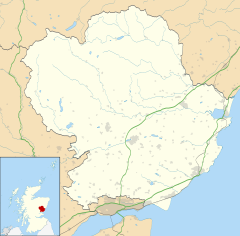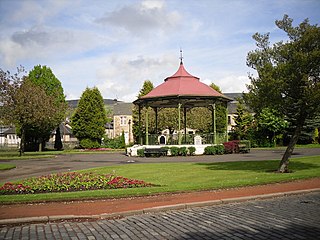
Kilsyth is a town and civil parish in North Lanarkshire, roughly halfway between Glasgow and Stirling in Scotland. The estimated population is 9,860. The town is famous for the Battle of Kilsyth and the religious revivals of the 18th, 19th, and 20th centuries. The town now has links with Cumbernauld at one time being part of Cumbernauld and Kilsyth District Council. The towns also have the same members of parliament at Holyrood and Westminster.

Cockenzie and Port Seton is a unified town in East Lothian, Scotland. It is on the coast of the Firth of Forth, four miles east of Musselburgh. The burgh of Cockenzie was created in 1591 by James VI of Scotland. Port Seton harbour was built by George Seton, 11th Lord Seton between 1655 and 1665.

Denny is a town in the Falkirk council area of Scotland. Historically in Stirlingshire, it is situated 7 miles west of Falkirk, and 6 miles (10 km) northeast of Cumbernauld, adjacent to both the M80 and M876 motorways. At the 2011 census, Denny had a resident population of 7,933.

Aberlemno is a parish and small village in the Scottish council area of Angus. It is noted for three large carved Pictish stones dating from the 7th and 8th centuries AD ; the stones can be viewed at any time in spring-autumn, but are covered by wooden boxes in the winter to prevent frost damage. Two stones stand by the B9134 Forfar-Brechin road, the Kirkyard Stone stands in the nearby graveyard of the parish church.

Shotts is a town in North Lanarkshire, Scotland. It is located almost halfway between Glasgow and Edinburgh. The village has a population of about 8,840. A local story has Shotts being named after the legendary giant highwayman Bertram de Shotts, though toponymists give the Anglo-Saxon scēots as the real source of the name. Shotts is the home of the 2015 world champion pipe band, Shotts and Dykehead Caledonia Pipe Band.
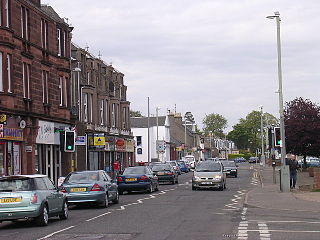
Monifieth is a town and former police burgh in the council area of Angus, Scotland. It is situated on the north bank of the Firth of Tay on the east coast. In 2016, the population of Monifieth was estimated at 8,110, making it the fifth largest town in Angus.

Oldhamstocks or Aldhamstocks is a civil parish and small village in the east of East Lothian, Scotland, adjacent to the Scottish Borders and overlooking the North Sea. It is located 6 miles (10 km) south-east of Dunbar and has a population of 193. The church was consecrated by Bishop David de Bernham, 19 October 1242. Its chancel is a fine example of late Gothic — probably fifteenth-century work.

Liff is a village in Angus, Scotland, situated 4.5 miles west-north-west of Dundee on a south-facing slope two miles north of the River Tay. It had a population of 568 in 2011. Surrounded by farmland, it has been described as 'haunted by wood pigeons and the scent of wild garlic' and having a 'wonderful view over the firth [of Tay]'. Half a mile to the east lies the site of the former Royal Dundee Liff Hospital, now given over to private housing. Further east lie Camperdown House and Park. Half a mile to the south is House of Gray, a large eighteenth-century mansion house in the neoclassical style, currently standing empty. The village contains twelve listed buildings, with others nearby.
Paul Anthony Hegarty is a Scottish football player and manager. He was captain of Dundee United during their most successful era in the 1970s and 1980s, winning the Scottish league championship in 1983 and the Scottish League Cup twice. Hegarty won eight full international caps for Scotland. He has managed Forfar Athletic, Aberdeen, Dundee United, Livingston and Montrose.

East Haven is a fishing village in the council area of Angus, Scotland. It is situated 1.5 miles (2 km) east of Carnoustie and 5 miles (8 km) south west of Arbroath. The closest city, Dundee, is 13 miles (21 km) to the west.

Banton is a small village situated near Kilsyth in North Lanarkshire, Scotland.

Murroes is a parish in Angus, Scotland, situated approximately 3 miles (4.8 km) north of Dundee city centre.
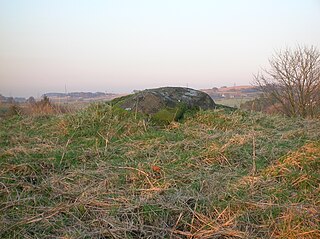
Carlin Stone or Carlin Stane is the name given to a number of prehistoric standing stones and natural stone or landscape features in Scotland. The significance of the name is unclear, other than its association with old hags, witches, and the legends of the Cailleach.

Charleston is a village in Angus, Scotland near Glamis.

Careston is a hamlet in Angus, Scotland that is in the parish of the same name, 5 miles west of Brechin. The parish and hamlet supposedly took their name from a stone laid in commemoration of a Danish chieftain, called Caraldston. It has a castle and church, although the local primary school closed in 2004.

The Battle of Barry is a legendary battle in which the Scots, purportedly led by Malcolm II, defeated a Danish invasion force in 1010 AD. Its supposed site in Carnoustie, Angus can be seen in early Ordnance Survey maps. The history of the event relies heavily on tradition and it is currently considered to be apocryphal. The battle was named for the Parish of Barry, rather than the village, and was formerly thought to have taken place at the mouth of the Lochty burn, in the vicinity of the area that is now occupied by Carnoustie High Street. While the battle is not historically authentic, its romantic appeal continues to capture the popular imagination.
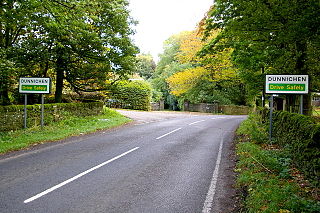
Dunnichen is a small village in Angus, Scotland, situated between Letham and Forfar. It is close to Dunnichen Hill, at which the Battle of Dun Nechtain is popularly believed to have been fought. The church is part of the parish of Letham, Dunnichen and Kirkden.

Redford is a hamlet in the parish of Carmyllie in Angus, Scotland. It is situated on high ground between Arbroath, on the coast, and the inland county town of Forfar. Carmyllie school is located in the settlement, as was the old Carmyllie railway station.

Panbride is a village and civil parish in the council area of Angus, Scotland. It is situated 0.5 miles (1 km) north-east of Carnoustie and 6 miles (10 km) west of Arbroath.

Dun is a rural parish in Angus, Scotland. It contains the House of Dun, home of the Erskine family and is a stop on the Caledonian Railway. It is located on the river South Esk, west of Montrose and east of Brechin. In 1785-7 a bridge was built there across the South Esk. The writer Violet Jacob was born at the House of Dun. William Chalmers Burns, a famous Scottish evangelist was born at Dun in 1815.

